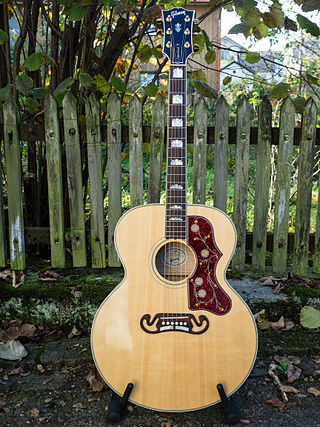
The steel-string acoustic guitar is a modern form of guitar that descends from the gut-strung Romantic guitar, but is strung with steel strings for a brighter, louder sound. Like the modern classical guitar, it is often referred to simply as an acoustic guitar, or sometimes as a folk guitar.

An electric guitar is a guitar that requires external amplification in order to be heard at typical performance volumes, unlike a standard acoustic guitar. It uses one or more pickups to convert the vibration of its strings into electrical signals, which ultimately are reproduced as sound by loudspeakers. The sound is sometimes shaped or electronically altered to achieve different timbres or tonal qualities from that of an acoustic guitar via amplifier settings or knobs on the guitar. Often, this is done through the use of effects such as reverb, distortion and "overdrive"; the latter is considered to be a key element of electric blues guitar music and jazz, rock and heavy-metal guitar-playing. Designs also exist combining attributes of the electric and acoustic guitars: the semi-acoustic and acoustic-electric guitars.

The guitar is a stringed musical instrument, that is usually fretted and typically has six or twelve strings. It is usually held flat against the player's body and played by strumming or plucking the strings with the dominant hand, while simultaneously pressing selected strings against frets with the fingers of the opposite hand. A guitar pick may also be used to strike the strings. The sound of the guitar is projected either acoustically, by means of a resonant hollow chamber on the guitar, or amplified by an electronic pickup and an amplifier.

In musical instrument classification, string instruments or chordophones, are musical instruments that produce sound from vibrating strings when a performer plays or sounds the strings in some manner.

A digital piano is a type of electronic keyboard instrument designed to serve primarily as an alternative to the traditional acoustic piano, both in how it feels to play and in the sound it produces. Digital pianos use either synthesized emulation or recorded samples of an acoustic piano, which are played through one or more internal loudspeakers. They also incorporate weighted keys, which recreate the feel of an acoustic piano. Some digital pianos are designed to also look like an upright or grand piano. Others may be very simple, without a stand.

An electric piano is a musical instrument that has a piano-style musical keyboard, where sound is produced by means of mechanical hammers striking metal strings or reeds or wire tines, which leads to vibrations which are then converted into electrical signals by pickups. The pickups are connected to an instrument amplifier and loudspeaker to reinforce the sound sufficiently for the performer and audience to hear. Unlike a synthesizer, the electric piano is not an electronic instrument. Instead, it is an electro-mechanical instrument. Some early electric pianos used lengths of wire to produce the tone, like a traditional piano. Smaller electric pianos used short slivers of steel to produce the tone. The earliest electric pianos were invented in the late 1920s; the 1929 Neo-Bechstein electric grand piano was among the first. Probably the earliest stringless model was Lloyd Loar's Vivi-Tone Clavier. A few other noteworthy producers of electric pianos include Baldwin Piano and Organ Company, and the Wurlitzer Company.

The acoustic bass guitar is a bass instrument with a hollow wooden body similar to, though usually larger than, a steel-string acoustic guitar. Like the traditional electric bass guitar and the double bass, the acoustic bass guitar commonly has four strings, which are normally tuned E-A-D-G, an octave below the lowest four strings of the 6-string guitar.

An instrument amplifier is an electronic device that converts the often barely audible or purely electronic signal of a musical instrument into a larger electronic signal to feed to a loudspeaker. An instrument amplifier is used with musical instruments such as an electric guitar, an electric bass, electric organ, electric piano, synthesizers and drum machine to convert the signal from the pickup or other sound source into an electronic signal that has enough power, due to being routed through a power amplifier, capable of driving one or more loudspeaker that can be heard by the performers and audience.
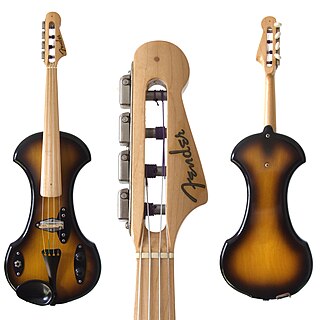
An electric violin is a violin equipped with an electronic output of its sound. The term most properly refers to an instrument intentionally made to be electrified with built-in pickups, usually with a solid body. It can also refer to a violin fitted with an electric pickup of some type, although "amplified violin" or "electro-acoustic violin" are more accurate then.
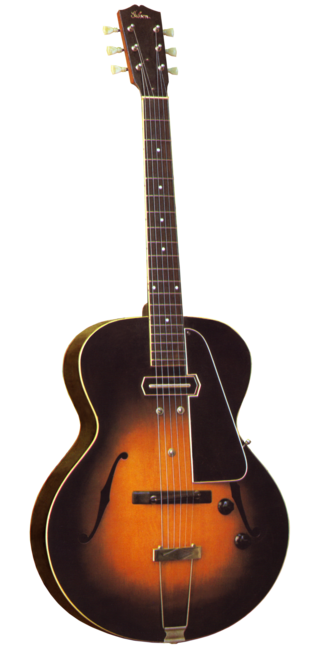
A semi-acoustic guitar, also known as a hollow-body electric guitar, is a type of electric guitar designed to be played with a guitar amplifier featuring a fully or partly hollow body and at least one electromagnetic pickup. First created in the 1930s, they became popular in jazz and blues, where they remain widely used, and the early period of rock & roll, though they were later largely supplanted by solid-body electric guitars in rock.
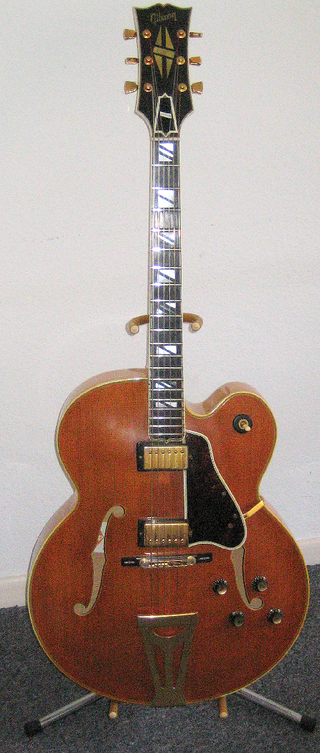
An archtop guitar is a hollow acoustic or semi-acoustic guitar with a full body and a distinctive arched top, whose sound is particularly popular with jazz, blues, and rockabilly players.

Jazz bass is the use of the double bass or electric bass guitar to improvise accompaniment ("comping") basslines and solos in a jazz or jazz fusion style. Players began using the double bass in jazz in the 1890s to supply the low-pitched walking basslines that outlined the chord progressions of the songs. From the 1920s and 1930s Swing and big band era, through 1940s Bebop and 1950s Hard Bop, to the 1960s-era "free jazz" movement, the resonant, woody sound of the double bass anchored everything from small jazz combos to large jazz big bands.

A pickup :)) is a transducer that captures or senses mechanical vibrations produced by musical instruments, particularly stringed instruments such as the electric guitar, and converts these to an electrical signal that is amplified using an instrument amplifier to produce musical sounds through a loudspeaker in a speaker enclosure. The signal from a pickup can also be recorded directly.

The electric upright bass (EUB) is an instrument that can perform the musical function of a double bass. It requires only a minimal or 'skeleton' body to produce sound because it uses a pickup and electronic amplifier and loudspeaker. Therefore, a large resonating structure is not required to project the sound into the air. This minimal body greatly reduces the bulk and weight of the instrument. EUBs must always be connected to an amplifier and speaker cabinet to produce an adequate audible sound. The EUB retains enough of the features of the double bass so that double bass players are able to perform on it.

A bass amplifier is a musical instrument electronic device that uses electrical power to make lower-pitched instruments such as the bass guitar or double bass loud enough to be heard by the performers and audience. Bass amps typically consist of a preamplifier, tone controls, a power amplifier and one or more loudspeakers ("drivers") in a cabinet.
An acoustic guitar is a musical instrument in the string family. When a string is plucked, its vibration is transmitted from the bridge, resonating throughout the top of the guitar. It is also transmitted to the side and back of the instrument, resonating through the air in the body, and producing sound from the sound hole. While the original, general term for this stringed instrument is guitar, the retronym 'acoustic guitar' – often used incorrectly to indicate the steel stringed model – distinguishes it from an electric guitar, which relies on electronic amplification. Typically, a guitar's body is a sound box, of which the top side serves as a sound board that enhances the vibration sounds of the strings. In standard tuning the guitar's six strings are tuned (low to high) E2 A2 D3 G3 B3 E4.

A guitar synthesizer is any one of a number of musical instrument systems that allow a guitarist to access synthesizer capabilities.
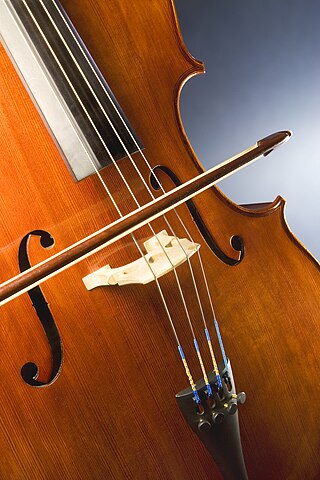
A bridge is a device that supports the strings on a stringed musical instrument and transmits the vibration of those strings to another structural component of the instrument—typically a soundboard, such as the top of a guitar or violin—which transfers the sound to the surrounding air. Depending on the instrument, the bridge may be made of carved wood, metal or other materials. The bridge supports the strings and holds them over the body of the instrument under tension.
Classical electric guitars, also known as nylon-string electric guitars, represent a unique fusion of traditional classical guitar design and modern electric guitar technology. These instruments combine the rich and warm tonal qualities of nylon-stringed classical guitars with the versatility and amplified sound capabilities of electric guitars. By integrating nylon strings with onboard electronics, pickups, and preamp systems, classical electric guitars offer musicians a wide range of sonic possibilities for various musical genres and performance settings.

The Yamaha CP-70 is an electric piano manufactured by Yamaha Corporation between 1976 and 1985. The instrument was based on earlier electric piano technology, but took advantage of improved pickups along with the company's longstanding experience in manufacturing acoustic pianos.



















